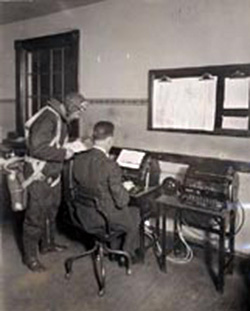

- Courtesy of the National Air and Space Museum, Smithsonian Institution
The first pilots who flew for the Post Office's airmail service were pioneers of flight. Their work blazed the trail for new, permanent airway routes and made nighttime flying routine.
To be a pilot in the early 20th century was an adventurous, difficult and dangerous job. The Post Office Department paid pilots well. From 1918 to 1926, airmail service pilots earned between $2,000 and $5,000 a year, plus five cents for every mile flown. This was two to three times what an entry-level postal clerk was paid.
Pilots could also earn national fame. Pilot Jack Knight became an overnight hero in 1921. Taking part in the first transcontinental airmail run, Knight successfully completed his assigned flight. When the next pilot refused to fly in darkness and bad weather, Knight rose to the challenge and delivered the mail. Without Knight's determination, airmail service would have suffered a major setback.

- Courtesy of the National
Air and Space Museum,
Smithsonian Institution
Jack Knight was one of many famous pilots of his day. Have you heard of Charles Lindbergh's record-setting first transatlantic flight? Did you know that for part of his flying career he transported the mail?
Aviation Innovation
Have you heard the phrase "flying by the seat of your pants"? What does it mean? The phrase evolved from the early days of aviation.
What does the phrase say about the work these pilots did?
Put yourself into the role of an airmail pilot by reading the following stories and completing the activities:
» Leg 1: Suit Up
» Leg 2: Logbook
» Leg 3: Forced Landing
